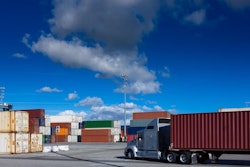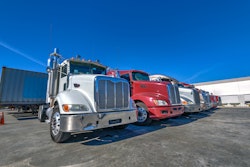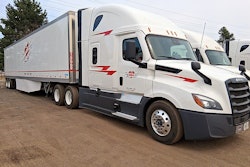The looming threat of tariffs continue to drive businesses to frontload inventories, adding more jobs in the transportation sector in April.
Latest data from the Bureau of Labor and Statistics showed that the truck transportation sector added 1,400 jobs in April – the fourth increase in the last six months after nearly a year of job losses.
Revised data shows that earlier reports had overstated gains from February and March, with only 4,000 jobs added during those two months, not 6,800 jobs as initially reported. Since October, trucking employment has grown by 10,000 jobs.
[Related: Trucking employment stabilizes near pre-pandemic levels despite recent job losses]
The unemployment rate in the U.S. transportation sector in April was 3.6%, a drop from 4.7% in April 2024, and slightly better than before the pandemic when it was 3.7% in April 2019. For comparison, during the peak of the pandemic, unemployment in the sector rose to 15.7%.
David Spencer, vice president of market intelligence at Arrive Logistics, said that April’s growth likely comes from businesses rushing to bring in extra inventory as a form of “proactive safety stocking,” creating a boost in short-term trucking demand.
Jobs in transportation and warehousing had the largest increase of up to 9,800 jobs, up slightly from the previous month (0.4% increase) and last year (up 21%). This was followed by couriers/messengers (up 0.5% from the previous month) and air transport (up 0.5%). Only water transport saw a slight decline (down 0.4%) and rail transportation remained steady at 0.1% from the previous month.
Aaron Terrazas, economist and guest lecturer at University of Washington, commented that the surge in the warehousing and storage sector is driven by the “consumer whiplash associated with uncertainty around trade policy.”
Spencer also noted that the growth in the transportation and warehousing segment illustrates the "safety stocking" behavior, as shippers pull forward inventories ahead of potential price increases, giving the freight industry a temporary boost.
But this could change quickly, depending on how a global trade war plays out, as well as compounding impacts from elevated tariffs with China, Spencer said.
“With imports and exports grinding to just a trickle compared to prior trade volumes, we should begin to see risk to the downside for employment as we enter May,” Spencer said, adding that if the 90-day pause on tariffs ends and more tariffs are enforced, imports could drop sharply. This would first hit drayage and intermodal carriers at ports and rail yards, then ripple out to the trucking sector.
U.S. Senators Alex Padilla (D-CA), Patty Murray (D-Wash), and Ron Wyden (D-Ore.) held a virtual news conference Thursday to emphasize the decline of container ships to West Coast ports and the effects of the administration’s policies across the economy.
“The drop in cargo volume caused by Trump’s tariffs will mean empty shelves when products don’t reach our stores, raising prices on everything from groceries to clothes to cars, and undoubtedly, [put] more Americans out of work,” said Padilla, who highlighted that Los Angeles and Long Beach ports handle 40% of the country’s imports.
The Port of Los Angeles on Thursday said that they expect imports to drop by about 35% in two weeks’ time.
A 2023 report found that total containerized cargo handled at the ports of Los Angeles and Long Beach supported 165,462 direct, induced, and indirect jobs, contributed to $21.8 billion of direct business revenue to the local service providers, and generated $2.7 billion of state and local taxes.
A drop of just 1% in cargo equates to a reduction of more than 6,800 direct, induced and indirect jobs, $700 million in lost wages, salaries and personal consumption annually, and $15.6 billion in total economic impact to the state. Of these, 2,769 direct jobs could be removed.
Starting in Q2, Jan Groen, economist and founder of Macro Market Notes, pointed out that import volumes are expected to decline as businesses have already replenished their inventories and consumers can only advance purchases of large items once. On top of that, implementation of higher tariffs will further suppress imports.
“This means large parts of the logistics system that funnels imported goods to wholesalers, retailers and consumers will sit idle,” said Groen. “This likely will hurt trucking employment over at least the coming three months, as a lot of these imports are not easily replaced through domestic production.”
Implications for labor market
Though the sector indicated strength in April, Terrazas pointed out a possible slowdown ahead, too. “We know that there is downside to this number heading into May with UPS recently announcing a planned 20,000 reduction to their headcount. Trucking industry employment is cautiously trending higher after contracting for much of the past year and a half but remains 4% below its summer 2022 peak.”
If tariffs stay high for the long haul, shifting production and consumption patterns will influence trucking companies and shippers to rethink their routing guides like they did during the pandemic, Terrazas said.
Groen added that as the economy adjusts to a new equilibrium under higher tariffs, import volumes will bounce back to some extent, especially from non-China sources (particularly from countries like Canada, Mexico, South Korea, and Japan).
However, Groen said these alternatives will often be more expensive and may not fully replace goods previously sourced from China. “Import volumes will, likely for a while, remain below pre-tariff hike levels. You likely will see a similar dynamic in trucking employment: a bounce back in trucking jobs but not quite to the same levels as seen pre-tariffs,” he said.
In the near term, Terrazas said that rising prices and consumer fears could likely lead to less freight movement and a softening labor market.














